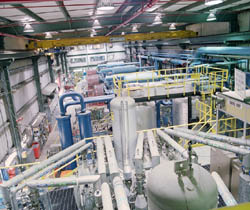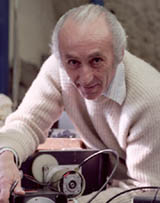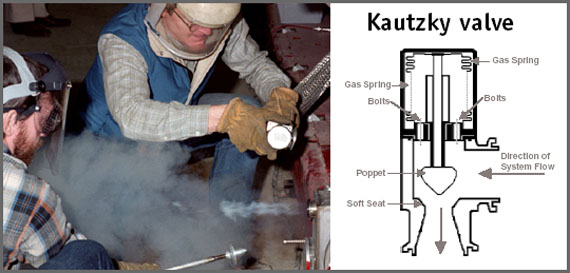 |
|
Cold, Hard Fact: No Tevatron Without Cryogenic System by Mike Perricone It all comes down to this: To supercool more than 1,000 superconducting magnets in a four-mile ring, achieving the zero electrical resistance for the 4,400-ampere current that makes the Tevatron uniquely the Tevatron, the massive and intricate cryogenic system at Fermilab must deliver a peak rate of 24 kW at 4.5 Kelvin (-269.5°C, about -450°F) through a circuit of 15 miles of vacuum-jacketed pipeline. Thanks to superconductivity, and to that cryogenic delivery system, power consumption for the Tevatron is just one-third what it would be at normal temperatures.
The world's largest system of its kind when completed in 1983, the Fermilab cryogenic system was named an International Historic Mechanical Engineering Landmark in 1993 by the American Society of Mechanical Engineers. Fermilab physicists Bill Fowler and Ron Walker, and engineer Claus Rode, were in charge of constructing the cryogenic cooling system, a hybrid design consisting of a large central helium liquefier and 24 satellite refrigerators. The lab organized a sitewide effort, with staffers from many departments, to meet the schedule for construction and commissioning. On May 29, 1983 the entire Tevatron was cooled down and operated for the first time. The cryo system passed another major test on July 3, 1983, with the Tevatron accelerating a proton beam to 512 GeV—the world's highest energy for a particle beam, doubling the energy of the original Main Ring accelerator, thanks to the near-absolute zero temperatures enabling the phenomenon of superconductivity.
All that gas has to go somewhere, in a big hurry, and in this case relief is spelled K-A-U-T-Z-K-Y. The quick-acting, self-sealing cryogenic relief valve that bears his name was developed by Fermilab engineer Hans Kautzky, now retired. More than 1,500 Kautzky valves around the Tevatron ring allow the system to "blow off steam" in the event of a quench. The poppet, the key element in the Kautzky valve, is able to open quickly and then reseat itself because it operates counter to the incoming flow. The relieving pressure is set by control gas from a bottle of helium in the service building. When the pressure in the magnets gets above the set point, the poppet of the valve begins to lift and quickly sets up a large differential pressure across the bellows separating the control and magnet pressures. This difference quickly snaps the valve fully open. As the pressure drops, the gas spring will close the valve. (see diagram) Jay Theilacker remembers many cloud-filled adventures in changing Kautzky valves when operators were still finding out how to make the system run smoothly.
"We had to change quite a few in the early days, due to screws that hold the superconductor in the ends of the dipoles coming loose and getting caught in the valve," said Theilacker, now head of Fermilab's Cryogenic Department. "We also had many that had welding rod stuck in them. The welding rod was used during construction of the component to hold open a flapper-type check valve in order to leak-check during magnet production. Many were left in the component and eventually got stuck in the Kautzky valve after a quench." In changing those valves, Theilacker added, "you can see that quite an interesting plume comes out." In its 20 years of operation, Fermilab's landmark cryo system has undergone several upgrades to increase its capacity and efficiency. But thanks to early innovations like the Kautzky valve, the system has kept the Tevatron cool and kept the physics flowing.
On the Web:
Beams Division
American Society of Mechanical Engineers: |
| last modified 11/5/2003 email Fermilab |
FRLsDFx9eyfrPXgV


